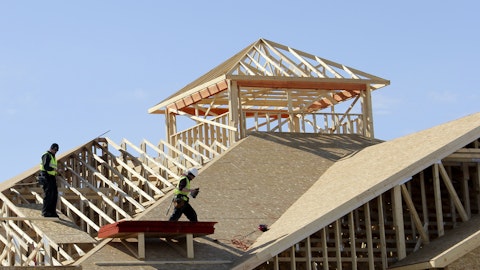BlueLinx Holdings Inc. (NYSE:BXC) Q3 2023 Earnings Call Transcript November 1, 2023
Operator: Call has been recorded. We will begin with the opening remarks and introductions. At this time I would like to turn the conference over to your host, Investor Relations Officer, Tom Morabito. Please go ahead sir.
Tom Morabito: Thank you operator and welcome to the BlueLinx Third Quarter 2023 Earnings Call. Joining me on today’s call is Shyam Reddy, our President and Chief Executive Officer and Andy Wamser, our Chief Financial Officer. At the end of today’s prepared remarks we will take questions. Our third quarter news release and Form 10-Q were issued yesterday after the close of the market, along with our webcast presentation. And these items are available in the Investors section of our website, bluelinxco.com. We encourage you to follow along with the detailed information on those slides during our webcast. Today’s discussion contains forward-looking statements. Actual results may differ significantly from those forward-looking statements due to various risks and uncertainties, including the risks described in our most recent SEC filings.
Today’s presentation includes certain non-GAAP and adjusted financial measures that we believe provide helpful context for investors evaluating our business. Reconciliations to the closest GAAP financial measure can be found in the appendix of our presentation. Now, I’ll turn it over to Shyam.
Shyam Reddy: Thanks, Tom, and good morning, everyone. We are pleased with our third quarter results given the higher interest rate environment that’s impacting the housing and building product sector. The BlueLinx team punctuated the quarter with strong margins and specialty products, which accounted for about 70% of our net sales. We continue to generate solid margins in our structural business, and when combined with our margins and specialty products, the team produced strong free cash flow. We also demonstrated our clear commitment to returning capital to shareholders by completing our share repurchase program and by announcing a new $100 million share repurchases authorization. These results reflect our relentless commitment to the company’s primary strategic priorities.
First, we remain focused on growing five key high-margin specialty product categories that are not only two-step distribution-friendly, they also support the long-term prospects of the housing industry and personal preferences of the American consumer. Engineered wood, siding, millwork, industrial, and outdoor living products, all of which we believe will generate higher net sales and gross profit results in a sustainable and programmatic manner with our customers. In addition to representing approximately 70% of our net sales, specialty products generated 80% of our gross profit dollars in the third quarter, in furtherance of the longer-term goal of specialty products making up 80% of net sales. We are accomplishing our objectives because our teams are leveraging our scale, geographic reach, selling capabilities, and product mix, including our commodity product offering to sell the BlueLinx’s value proposition, which includes our expanded specialty product offerings and value-added services in key markets.
These expanded partnerships highlight the confidence and faith our suppliers have placed in our nationwide capabilities and our commitment to providing best-in-class products and services to our customers. Second, we continue to drive operational pricing and procurement excellence deeper into the DNA of the company. These efforts have continued to support our customer experience, solid margin levels in specialty and structural products, and a cost structure that is in line with fluctuating and seasonal levels of demand. We are effectively managing our costs as our adjusted EBITDA margin year-to-date is 6%, which we believe is strong given the downward pressure associated with wage, benefits, and other SG&A inflation on top of challenging market conditions.
We are also making technology investments to support our current growth strategy and to prepare for our digital transformation journey. For example, we have strengthened our data warehouse and analytical capabilities, upgraded some of our back office tools, expanded EDI capabilities, and enhanced our general technology hardware and infrastructure in our warehouses. We’ll continue to explore ways to leverage technology to further enhance our sales, operational pricing, and procurement excellence initiatives. Third, we remain committed to exploring and executing on opportunities to grow the business via organic expansion in new markets and M&A. The industry remains fragmented, providing the potential for future expansion opportunities through organic market expansion and M&A efforts.
We are targeting opportunities geographically and by specialty product line. Importantly, we are going to be disciplined with any potential expansions, geographic or otherwise, to ensure they support long-term value creation. Vandermeer Forest Products, which joined the BlueLinx family just over one year ago, is a great example of the muscle our team has developed to do a reasonably sized deal, integrate it well, and leverage the collective skills and strengths of both teams to expand BlueLinx into new markets successfully in a short period of time. As you may recall, Vandermeer provided a strong platform for growth in the Pacific Northwest by giving us the ability to serve all 50 states and to grow our specialty products business in new areas of the country.
A year later, Vandermeer is performing very well and has significantly exceeded our EBITDA expectations from the time of the transaction. The business is not only integrated with the rest of BlueLinx, it is a strategic focus area for growing our business via BlueLinx supplier relationships and our commercial excellence capabilities. We’re also enhancing the operational capabilities of the Pacific Northwest business by putting our centralized operational center of excellence to work for it in ways they never experienced prior to joining the BlueLinx family. Our strategic priorities are closely tied with our capital allocation philosophy, which is disciplined and focused on reinvesting in business initiatives that allow us to grow sales, improve productivity, expand our geographic reach, and provide better service.
This discipline will drive organic growth while giving us the opportunity to return capital to shareholders. Our financial position remains strong with liquidity of $816 million at the end of the third quarter, including a record $470 million a cash on hand. As a result, we have the flexibility to make strategic investments that are designed to grow the business and to be more efficient. During the third quarter, we invested $5 million in capital expenditures to improve our business. We also returned approximately $18 million to shareholders through share repurchases under our previous $100 million share repurchase program, which is now complete. Our board of directors has approved a new $100 million share repurchase authorization further demonstrating our confidence in our recent performance and in our long-term growth strategy.
Now moving on to our third quarter results. As you all know, the year-over-year comps have been tough, not just for us, but for everyone in the housing and building products industry. The comparable quarter last year was at the tail end of a low interest rate in pandemic-induced housing boom. With higher interest rates slowing the rate of housing starts and repair and remodel activity, the current business environment is challenging. Fortunately, however, our teams and supplier partners, combined with the faith and confidence our customers have placed in BlueLinx, enable us to compete effectively in the markets we serve as evidenced by our solid financial performance. Naturally then, I am very pleased with the team’s efforts to deliver a solid quarter for our shareholders in the current environment, and with tough year-over-year comparisons as they headwind.
Our teams are committed to generating more profitable specialty product sales, driving value-added pricing, and producing solid returns on working capital to ensure that we can position ourselves to win in the market conditions we’re dealt with and to invest in our long-term success, hence the solid results we delivered. To be clear, our success is attributable to our teams and their relentless commitment to deliver what matters to our customers so they can successfully grow their business. We generated net sales of $810 million and $50 million in adjusted EBITDA at a 6.2% adjusted EBITDA margin and approximately 70-30 specialty structural product net sales mix. Adjusted net income was $27 million or $2.98 per share. We delivered solid gross margin performance in the third quarter with specialty products at 19.8%, the highest level of the year and structural products at 11.3%.
Our focus on commercial and operational excellence led to effective pricing and cost management, which were contributing factors to our sequential margin improvement of 100 basis points from the second quarter. Our continued focus on working capital has generated significant improvements in operating cash flow. Year-to-date, we have produced our inventory by over $120 million with most of the reduction coming from the specialty products category. We also generated free cash flow of $73 million in the third quarter. As Andy will discuss in further detail, similar to the first and second quarters of 2023, we experienced depletion and volume declines in some specialty product categories. That said, during the third quarter, average daily volumes of specialty products remained consistent with the second quarter.

Turning to our perspective on the broader housing and building products market, looking ahead into the fourth quarter of 2023, industry sources are suggesting a deceleration in the positive momentum observed during the spring and early summer. Builder sentiment has decreased in recent months as mortgage rates have continued to increase and home pricing remains stubbornly high. This is making housing less affordable for many consumers, particularly first-time buyers. It is difficult to predict the interest rate in overall macroeconomic environment, which is causing the industry to be cautious and its forecast to be muted. Repair and remodel spending continues to be lower than the elevated levels of the past two years. However, home equity levels remain high, allowing owners to fund repair and remodel projects, albeit smaller ones.
To the first four weeks of Q4, we have maintained solid margins for specialty products, although daily volumes are slightly down compared to what we saw during the recent quarter. That said, they’re in line with historical seasonality, which we believe further demonstrates normalization. Structural margins have compressed as prices declined throughout October, though daily volumes are slightly higher. Although the near-term outlook remains uncertain, we still believe in the long-term prospects of the building products industry, thereby justifying our strategic and investment focus, the fundamental undersupply of homes, supportive demographic shifts, aged housing stock, necessary repair activity, and high levels of home equity should continue to benefit the building products industry and BlueLinx.
In summary, we delivered solid quarterly financial results despite the challenging environment for housing and tough year-over-year costs. We’re also making good progress on our strategic priorities, as seen by our specialty product expansion efforts, margin performance, strong cash generation, and capital allocation initiatives. We continue to maintain our price and cost discipline, while proactively managing our working capital to generate strong operating cash flows, key strengths of BlueLinx in light of the macro uncertainties in the lingering possibility of an economic slowdown. This discipline will serve us well as the housing and building product sector continues to normalize. As a result of our prudent management of the business, we have a strong balance sheet that allows us to reinvest in the business to pursue a digital transformation strategy, to expand geographically and to selectively pursue acquisitions, all of which position us well for the long-term prospects of the business, while providing us with flexibility to return capital to shareholders.
I’d like to end by thanking my fellow BlueLinx associates for their continued grip, tenacity, and competitive spirit in a challenging housing environment, and for their continued dedication to our customers and suppliers. I’ve met with so many of our teams across the country in the last few months. Meeting with them has provided an opportunity to be close to the business and our efforts to support customers, while allowing me to feel the pulse of the organization, its heartbeat. Meeting with customers in our markets, in addition to our strategic suppliers, has also provided valuable insights. And when combined with the direct feedback provided by our associates, we are able to make better informed decisions to run the business in these challenging macroeconomic conditions, and to make strategic investments that position the company to take full advantage of the underlying fundamentals of the housing industry that support long-term growth.
So thanks to our customers and suppliers for enabling us to be better, our teams are so dedicated to our customers as their commitment to enhancing the customer experience is palpable. Not a day goes by without me feeling a great sense of pride and privilege being on their team. Now I’ll turn it over to Andy, who will provide more details on our financial results and capital structure.
Andy Wamser : Thanks, Shyam, and good morning, everyone. Let’s first go through the consolidated highlights for the quarter. Overall, we delivered solid third quarter results highlighted by strong margins in both our specialty and structural product categories. Net sales were of $810 million, down 24% year-to-year. Specialty product sales were down 23% from the prior year due to a combination of deflation and lower volumes. Structural product sales were down 25%, also due to significant year-over-year declines in wood-based commodity prices and lower volumes. As a reminder, when reviewing the year-over-year comparisons, it’s important to point out that in the third quarter of 2022, we were experiencing unusually high levels of demand and significant price inflation across the business.
So while the variances are quite significant, we are pleased with the financial results we generated this quarter considering recent market conditions. Total gross profit was $139 million and gross margin was 17.2%, down 70 basis points from the prior year period. SG&A was $91 million, flat with the prior year period as lower delivery costs were offset by higher operating expenses due to the Vandermeer acquisition. Net income was $24.4 and diluted EPS was $2.71 per share. Adjusted net income was $26.8 million and adjusted diluted EPS was $2.98 per share. The third quarter tax rate was 27.2% in line with our expectations and for the fourth quarter of 2023, we anticipate our tax rate to be in the 20% to 24% range. Adjusted EBITDA was $50 million for 6.2% of net sales.
Turning now to the third quarter result for specialty products. Net sales were $559 million down 23% year-over-year. This decline was driven by a combination of deflation and lower volumes across several specialty product categories. Growth profit from specialty product sales was $111 million down 27% year-to-year. Specialty growth margin was 19.8%, a strong margin but down 110 basis points from last year. To the first four weeks of Q4, specialty product growth margin was in the range of 18% to 19% with daily sales volumes slightly down compared to the third quarter of this year but in line with historical seasonality. Now moving on to structural products. Net sales were $251 million, down 25% compared to the prior year period. This decrease was primarily due to the significant year-over-year decline in average composite lumber and panel prices as well as volume.
Growth profit from structural products was $28 million, a decrease of 25% year-over-year and structural growth margin was 11.3% consistent with the same period last year. In the third quarter of 2023, average lumber prices were about $437 per 1,000 board feet and panel prices were about $636 per 1,000 square feet, a 26% and a 5% decrease respectively compared to the averages observed in the third quarter of 2022. Sequentially, comparing the third and second quarters of 2023, these prices were up 7% and 20% respectively. The sequential increase helped support the structural margins observed in the quarter. However, lumber and panel prices declined throughout the third quarter and finished the last week of September at $422 and $626 respectively.
These prices have declined further in the first four weeks of the fourth quarter and are now $376 per 1,000 board feet and $572 per 1,000 square feet respectively. Our strong structural margin continues to reflect the excellent job our team does to manage commodity cost volatility risk through leveraging consignment and utilizing centralized purchasing and pricing to keep structural inventory levels low. Through the first four weeks of Q4, structural products gross margin was in the range of 9% to 10% with daily sales volumes slightly up compared to the third quarter of this year. This excludes any net impact that could arise from inventory adjustments. Looking at our balance sheet, our liquidity remains excellent due to the strong execution of our strategic initiatives and effective management of working capital.
As of the end of the third quarter, cash-on-hand reached a record level of $470 million, an increase of $51 million from Q2 to Q3. When considering our cash-on-hand and undrawn revolver capacity of $347 million, available liquidity was $816 million at the end of the third quarter, also a record. Total debt including our financing leases was $577 million and net debt was $107 million. Our net leverage is now 0.5 times and we have no material outstanding debt maturities until 2029. Our balance sheet is in excellent shape and when combined with our solid EBITDA and strong cash generation, we are well-positioned to support our strategic initiatives. These include capital allocation projects and investments and our highest return opportunities such as organic and inorganic growth investments and share repurchases.
Now moving on to working capital and free cash flow. During the third quarter, we generated operating cash flow of $78 million and free cash flow of $73 million. Our third quarter cash generation was supported by earnings and a net benefit from working capital, primarily related to a reduction of approximately $15 million in inventory. Specifically, we ended the third quarter with $364 million of inventory down over $120 million from beginning of the year. Turning now to capital allocation. During the quarter, we spent approximately $5 million in CapEx, which were primarily for enhancements to our distribution branches. For the year, we still expect capital investments to remain around $30 million, focusing on facility improvements and further upgrades to our fleet.
Also during the third quarter, we purchased approximately $18 million of a company’s common stock through an open market transaction under our prior $100 million share repurchase program, which as of last month is now complete. As Shyam mentioned, the board has approved another $100 million share repurchase authorization. We plan to be opportunistic in the market when repurchasing shares. As a reminder, this is our second $100 million share repurchase authorization in the last two years. Our guiding principles for capital allocation remain consistent. We intend to maintain a strong balance sheet which enables us to invest in our business through economic cycles, pursue a disciplined geographic expansion and M&A strategy as well as return capital to shareholders.
We also plan to maintain a long-term target net leverage of three times or less. Overall, we are pleased with our third quarter results highlighted by our strong margins and free cash flows, especially when considering the challenging environment. Our strong balance sheet positions us well to execute on our strategy and provide return to our shareholders as further evidence by our new share repurchase authorization. Operator, we are now ready to take questions.
See also 11 Tech Stocks to Sell Now According to Cathie Wood and 12 Best Asia ETFs to Buy.
Q&A Session
Follow Bluelinx Holdings Inc. (NYSE:BXC)
Follow Bluelinx Holdings Inc. (NYSE:BXC)
Operator: Thank you. Ladies and gentlemen, we will now be conducting a question and answer session. [Operator Instructions] Our first question comes from the line of Greg Palm with Craig-Hallum Capital Group. Please go ahead.
Greg Palm: Yes, good morning everybody. Thanks for taking the questions. I guess I wanted to start with a little bit of the outlook commentary. It suggests October volumes more or less in line with that of Q3. Just to be clear, is that normal? I assume volumes would likely trend lower in the months of November and December versus October. So I just, maybe wanted to be sure. I was thinking about that right. Maybe get in the point, should we expect normal seasonal trends in Q4 versus Q3?
Andy Wamser: Hey, Greg. This is Andy. It’s a great question. What I would say is, October normally aligns with some of the trends that we’ve seen in the third quarter. And as a reminder, our second and third quarters, I’d say in a more normalized market, which we’re experiencing right now, are generally our highest. And so, you’re on point, when we think about October, the trends were pretty decent in terms of the volume outlook, you know, as we still have to close out the month. But the, as we look to November and December, we then would see a dip certainly in that seasonality. So, we certainly would expect, I would say, the fourth quarter to be in line. We’re not trying to message the fourth quarter would be in line with the third quarter in terms of profitability.
Greg Palm: Okay. Understood. And then, you know the gross margin within specialty was, I’d say a highlight again. I’m just curious, are there certain categories within that you’re focusing on more, whether it be higher margin product lines and kind of long-term. How do you think about the focus there, whether it be on higher margin product lines versus maybe higher growth opportunities?
Shyam Reddy: Yes, another great question. The way I’d frame it is, when we look at the specialty margin in the third quarter, it certainly was a high mark of the year so far at 19.8%. As we saw or we mentioned, we thought as we look to the fourth quarter, it’s sort of trending in 18% to 19%, so I’d say a modest sort of slight dip. When I think about some of the trend lines, I would say EWP, millwork siding continues to do well with some of those volumes, and as those volumes have performed pretty well, those three categories have certainly helped the margin profile. But I would say, we’re focused on all five, the ones we consistently mentioned. But those are the three that really helped in the quarter.
Andy Wamser: Yes. Just to add to that. As it relates to our margins, we’re leveraging our pricing and service proposition capabilities to make sure we’re pricing competitively by charging the appropriate price for the product and service offering we provide, while then thinking strategically about our sales based on those characteristics and that customers were selling to. So basically, those who buy more from us get better deals than those who don’t. And ultimately, we’re thinking about sales growth in the context of long-term value creation, which is — and then a diversified product portfolio helps us execute successfully on that objective.
Greg Palm: Understood. Helpful color. I will leave it there. Thanks.
Andy Wamser: Thanks, Greg.
Operator: Thank you. Our next question comes from Reuben Garner with Benchmark Company. Please go ahead.
Reuben Garner: Thank you. Good morning, everybody.
Andy Wamser: Good morning, Reuben.


